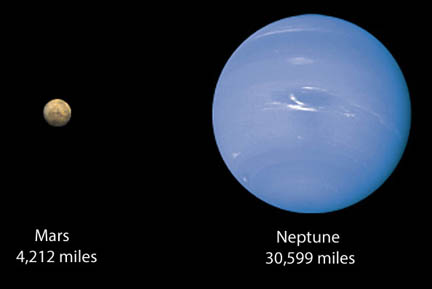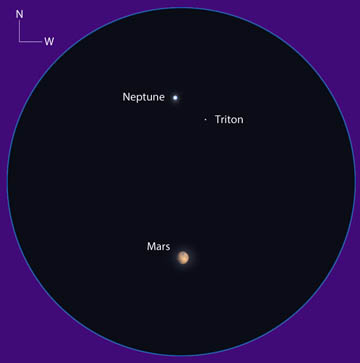Astronomy - Mars Meets Neptune on New Year’s Eve
Doing anything on New Year's Eve? Before you start toasting, don't miss an exceptionally close conjunction of Mars and Neptune.

Mars and Neptune are far apart in terms of size, temperature, and composition, yet each came from the same pot — the solar nebula that birthed all the planets.
Source: Lunar and Planetary Institute
Source: Lunar and Planetary Institute
What an unlikely pair. A small, sunburned desert planet half the size of Earth scrunched up against a big blue ice giant with an oceanic atmosphere. On New Year's Eve, Mars and Neptune will wheel across the twilight sky as close together as two strangers in a New York subway car.
That evening, as seen from the East Coast, only 14 arcminutes (14′ or just 0.2°) will separate the two planets. Mars, being much closer to Earth, has a greater apparent motion across the sky; a careful observer can actually see it move slightly eastward each night against the background stars with only the naked eye. As it glides eastward on December 31st, the Red Planet approaches Neptune more closely with each passing hour. When dusk finally reddens the sky in the Pacific Northwest, the chummy couple will be only 9′ apart.

This map shows the sky facing southwest around nightfall on Saturday evening, December 31st. Mars is located about a fist (at arm's length) to the upper left of Venus in central Aquarius. Binoculars and small telescopes will show Neptune next to Mars. Joining the scene is a beautiful crescent Moon lower down in the west.
Map: Bob King; source: Stellarium
Map: Bob King; source: Stellarium
It gets better. The distance between them shrinks to just 1 arcminute or 0.016° around 12:45 a.m. Central Standard Time on January 1st. Man, that's close! Pity the planets will have already set or be near setting for the continental U.S. and Canada. But not for Hawaii. Mars and Neptune will still be up in the western sky around 8:45 p.m. Hawaiian-Aleutian Standard Time. I really need to get to Hawaii more often — and not just because they have great conjunctions there.

Binocular simulation of Mars and Neptune viewed from three cities around 6 p.m. local time on December 31st. The planets' separation will be 22′ (London), 15′ (New York City) and 9′ (San Francisco). North is at upper right.
Maps: Bob King; source: Stellarium
Maps: Bob King; source: Stellarium
The amazing thing with all close conjunctions such as this one is how apparently close two planets can get when in reality they're incredibly far apart. They only appear like they're almost touching because we see them along the same line of sight. Truth to tell, the two are a cool 2,675,000,000 miles apart. Mars seems only a stone's throw from Earth at 150 million miles compared to Neptune's 2.8 billion miles, but line 'em up and it's party time.
So what exactly will we see? Neptune is invisible without optical aid, but lucky for us, very little such aid is needed. The remote planet pops into view with a pair of 50-mm (or larger) binoculars and in virtually any telescope. Point your glass at Mars, and look for a little point of light a very short distance above and to its left. Neptune will be the only close "star" to Mars. Farther west, in Hawaii, Neptune will glimmer above and a tad to the right of the Red Planet.

Mars and Neptune just 1′ apart as viewed from Honolulu on Dec. 31 local time. The simulated magnification here is about 350-400x! That tells you how amazingly close these two planets will be.
Map: Bob King; source: Stellarium
Map: Bob King; source: Stellarium
Binoculars will easily split the duo except possibly during their closest approach. Then, depending on the binocular's magnification, the otherwise untouchable worlds might appear to touch.
I encourage you to observe Mars and Neptune together at high magnification in a telescope. Mars will appear gibbous and 5.8″ across compared to Neptune's 2.3″. The color contrast between the two should be striking: red ocher and blue chill.
If you're using an 8-inch or larger instrument be sure to look for Neptune's largest moon, Triton, which will appear as a faint spark of 14th-magnitude light immediately south-southwest of the planet.
While Mars and Neptune are closest on New Year's Eve, they'll still neighbors on the 30th, when the blue planet lies about 1° to the upper left of Mars and again on January 1st, when it's 0.5° to the lower right of Mars. If you've never seen the eighth and (so far) final planet in our solar system, it couldn't be easier. All you need now are clear skies. Yeah, I know, that's the hard part.
And before I forget — Happy New Year! May 2017 provide clear nights and fantastic sights for all.
No comments:
Post a Comment